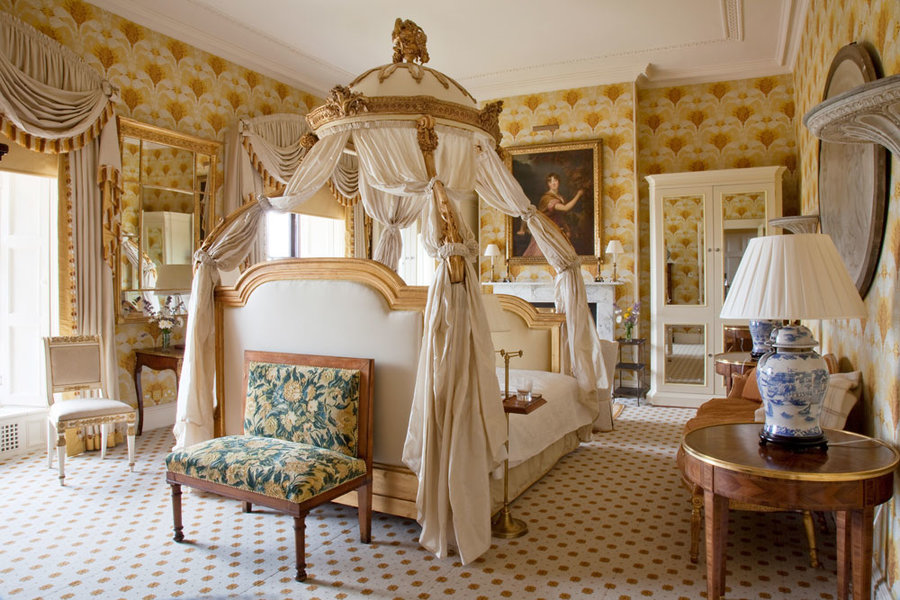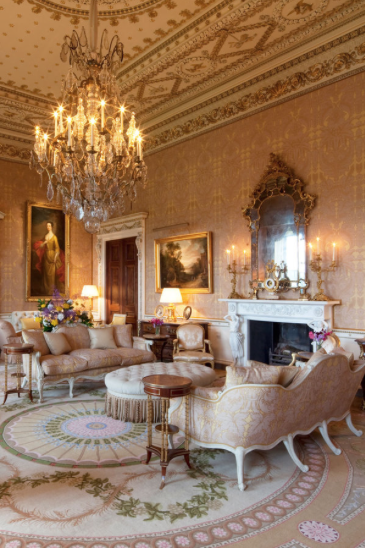Ballyfin: Ireland's Finest Country House Hotel
By CHRISTOPHER MASON
The Gold Drawing Room at Ballyfin
Set in the foothills of the Slieve Bloom mountains in County Laois, 60 miles southwest of Dublin, the Neoclassical mansion of Ballyfin was erected in 1826 to trumpet the wealth and prestige of Sir Charles Coote, Premier Baronet of Ireland. When the Coote family fell on hard times after World War I, the estate was sold for a measly £10,000 and became Ballyfin College, a boys’ school run by Catholic monks who were unable, or disinclined, to manage its upkeep. After decades of neglect, the property was in a pitiful state of disrepair. Delicate plasterwork in the Gold Drawing Room had been destroyed by seeping rainwater when its current owner, Fred Krehbiel, a Chicago-based businessman, first visited in 2000.
The Westmeath Bedroom, named after Marianne, Countess of Westmeath, whose portrait, by the studio of Sir Thomas Lawrence, hangs above the fireplace. (Her extracurricular exertions in a carriage with the Honourable Augustus Cavendish-Bradshaw inspired one of the most scandalous divorces of the 1790’s.)
After 40-odd years of global peregrinations as an executive at an electronics corporation, Krehbiel had spent countless nights in luxury hotels, and he and his Irish-born wife, Kay, were tempted to dip their toes into the hospitality trade. “I felt it would be interesting and fun to find an old property we could turn into a small hotel,” said Krehbiel, an earnest, square-jawed Midwesterner of Swiss descent, when I paid a visit to Ballyfin last winter, five months before its scheduled opening in May. As we warmed ourselves by the hearth in the Saloon—a butter-yellow reception hall with Corinthian columns and a pair of gilded mirrors designed by Robert Adam and made by Thomas Chippendale—Krehbiel explained that his vision was to “re-create the feeling of staying in a very grand Irish house where comfort is the key ingredient.”
The Conservatory and Library at Ballyfin
In doing so he appears to have taken to heart the punning family motto of the builder, the ninth baronet Coote: Coûte que coûte, or “Cost what it may.” Millions were expended on Ballyfin’s lavish restoration—Jim Reynolds, the Irish landscape designer recruited to oversee the entire project, was reluctant to specify a figure. He would acknowledge only that the estate was acquired in 2002 for 7 million, a matter of public record. “That’s the only number we remember,” Reynolds told me in his salty Irish brogue, roaring with laughter at my impertinence for asking about costs. “There never was a budget,” he insisted. “We did what had to be done.”
The Waterfall, graced by Neptune, at Ballyfin
The renovations proved a boon to the local economy, providing employment to more than 200 workers, including visiting specialists. Conservation experts were called in to examine the mansion’s crumbling sandstone façade and determined that 60 percent of the stone needed to be replaced—a two-year project in itself. A 500-foot-long underground tunnel was installed, running from the estate’s 18th-century stables to the mansion’s basement, so as not to blight the pastoral landscape with commercial vehicles. The tunnel helps create the illusion of inhabiting a paradise unconnected to life’s daily grind.
“The idea was that you lived in an ideal world, free of care and travail,” Reynolds said. “Nothing will go through the front door but the guests and their bags.” The hotel accommodates a total of 29 guests, who are attended to by a full-time staff of 40.
The Gold Drawing Room
Of the 15 guest rooms and suites, one of the more fanciful is the Westmeath Bedroom, named after Marianne, Countess of Westmeath, whose portrait, by the studio of Sir Thomas Lawrence, hangs above the fireplace. (Her extracurricular exertions in a carriage with the Honourable Augustus Cavendish-Bradshaw inspired one of the most scandalous divorces of the 1790’s.) The room is dominated by a carved French bed with a domed canopy of cream silk tethered to a gilded frame.
Krehbiel invited the current baronet, Sir Christopher Coote, to visit Ballyfin, with the hope of learning more about the estate’s history. After seeing the American’s plans to restore the estate, Coote offered to sell Krehbiel 17 of his family portraits so they could again grace the walls of Coote’s ancestral home. The portraits are now installed in the Stair Hall, an ornate space with turquoise walls and a cantilevered staircase. Visitors are met by the flinty stare of the armor-clad Sir Charles (1581–1642), a soldier-adventurer and the first Coote to set foot in Ireland; his “prominent and excellent military service” earned him a baronetcy from James I in 1623. “By all accounts he was the most rapacious and murderous individual,” Reynolds says. “His reputation was worse than Cromwell’s.”
Subsequent generations of Cootes were more congenial. In the grand entrance hall is a splendid Roman floor mosaic brought back from a Grand Tour taken by the ninth baronet and his wife, Lady Caroline, a niece of the Earl and Countess of Meath. (No relation, apparently, to the disreputable Countess of Westmeath. However, another of Lady Caroline’s uncles was “Buck” Whaley, a notorious gambler, wastrel, and anti-Catholic zealot.)
The Treillis Bedroom at Ballyfin
During my visit in January, afternoon tea—a sumptuous affair with fruitcake and raspberry jam—was served in the library, an 80-foot-long room with a fireplace at either end. A bow window in the center offered a glorious view of a grand Italian marble fountain, lined up with the center of the window. When the Krehbiels first saw it, the fountain was two feet off center. “Someone said, ‘You shouldn’t move it. It’s so wonderfully Irish,’ ” Reynolds told me. “But Fred is Swiss,” he added drily.
To the left of a fireplace, a hidden door behind a bookcase swings open to reveal a spectacular curvilinear glass-and-steel conservatory with Roman statuary, wicker furniture, and potted palms. Neglected by the monks, the frame was severely corroded and had to be dismantled and shipped, piece by piece, to England for restoration. Meryl Long, a recent visitor, remembers her father, Richard Guinness, describing his astonishment at finding bananas growing in the conservatory in the early 1920’s—an almost inconceivable luxury in Ireland at the time.
Alas, Reynolds has no plans to revive the cultivation of bananas. But he has planted a kitchen garden to produce fresh vegetables. And he has introduced free-range chickens to supply eggs. The hotel’s chef, Fred Cordonnier, was previously in charge of Restaurant Patrick Guilbaud at the Merrion hotel, Dublin’s only Michelin two-starred restaurant; at Ballyfin he will apply his French technique to the local bounty, whether a porcini risotto with slices of Jerusalem artichoke or tender lamb from the Slieve Bloom mountains. “They graze on heather and wildflowers,” says Cordonnier, explaining that this gives the meat its delectable flavor.
The Sir Christopher Coote suite at Ballyfin
And then there are the grounds. Ballyfin sits on 600 acres, with a vast lake in front of the house and a network of diverting walkways to a rockery with ferns, all modeled on the style of Lancelot “Capability” Brown. Outdoor activities include boating and fishing on the lake; tennis; bowling; croquet; and bicycling on more than six miles of paths. For those who wish to venture beyond the property’s 4 1/2-mile stone-walled perimeter, there is horse trekking in the Slieve Blooms, as well as outings to Birr Castle, with its famous arboretum and gardens, and the Lutyens gardens at Heywood, in Ballinakill. The Heritage golf course, designed by Seve Ballesteros, is 20 minutes away.
Will Krehbiel’s spectacular gamble pay off? With Ireland’s economy still in disarray, no doubt Ballyfin will have to look abroad for much of its clientele. That said, the hotel’s central location—halfway between Dublin and Shannon—makes it an ideal stopping point for travelers bound from the capital to the southwest coast.
“We’re certainly not going to get a return on our investment,” Krehbiel says, though he betrays not a hint of regret.
The Lady Kildare suite at Ballyfin
Ballyfin, Co. Laois; 353-57/875-5866; ballyfin.com; doubles from $1,330, including all meals.









